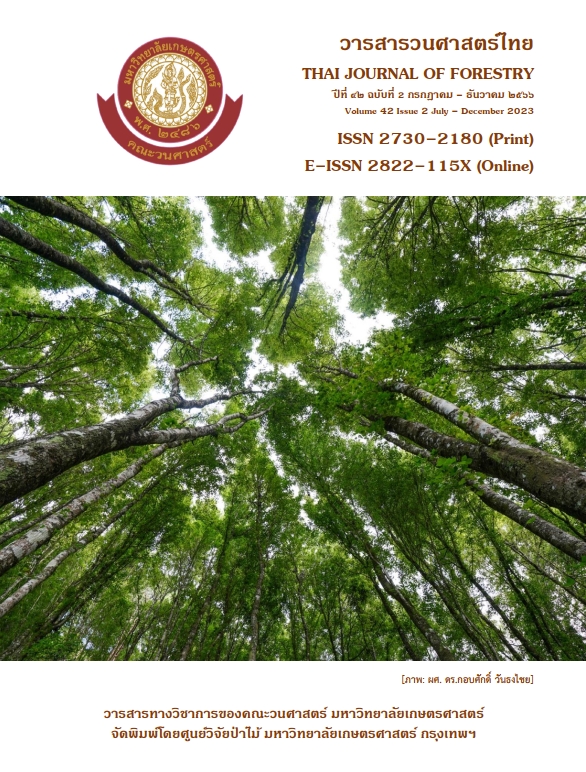ศักยภาพเส้นใยต้นอ้อยักษ์ (Arundo donax L.) ในประเทศไทย สำหรับอุตสาหกรรมกระดาษคราฟท์
Main Article Content
บทคัดย่อ
การศึกษาศักยภาพของเส้นใยต้นอ้อยักษ์ในประเทศไทยเพื่อนำมาใช้เป็นวัตถุดิบในอุตสาหกรรมเยื่อกระดาษ โดยการศึกษาองค์ประกอบทางเคมีและสมบัติทางสัณฐานวิทยาของเส้นใย แล้วจึงนำมาผลิตเยื่อคราฟท์อ้อยักษ์ โดยใช้แอคทีฟอัลคาไลน์ (active alkali) ร้อยละ 20-25 ซัลฟิดิตี้ (sulfidity) ร้อยละ 30 ภายใต้อุณหภูมิสูงสุดที่ 170 องศาเซลเซียส ใช้เวลาที่อุณหภูมิสูงสุด 60 นาที จากนั้นหาผลผลิตเยื่อ ค่าตัวเลขคัปปา เพื่อประเมินความเหมาะสมในการเป็นวัตถุดิบทางเลือกที่ใช้ในอุตสาหกรรมกระดาษคราฟท์ต่อไป จากผลการศึกษา พบว่าองค์ประกอบทางเคมีของอ้อยักษ์ประกอบด้วย ปริมาณโฮโลเซลลูโลสร้อยละ 74.88 เซลลูโลสร้อยละ 41.26 ลิกนินร้อยละ 22.42 เพนโทซานร้อยละ 24.59 สารแทรกร้อยละ 10.22 และขี้เถ้าร้อยละ 4.46 สัณฐานวิทยาของเส้นใยอ้อยักษ์มีลักษณะเรียวยาว มีความยาวของเส้นใยอยู่ที่ 1.45 มิลลิเมตร และความกว้างของเส้นใย 24.01 ไมโครเมตร และให้ผลผลิตเยื่อร้อยละ 51.54 และมีส่วนตกค้างร้อยละ 1.30 ในขณะที่ตัวเลขคัปปาอยู่ที่ 25.2 จะเห็นได้ว่าเยื่อคราฟท์อ้อยักษ์มีศักยภาพที่ดีกว่าเยื่อคราฟท์จากพืชที่ไม่ใช่เนื้อไม้บางชนิดและพืชที่มีเนื้อไม้ เช่น เยื่อจากชานอ้อย ยูคาลิปตัสและไม้ใบแคบ เมื่อทำการตีเยื่อแต่ละชนิดจนได้ค่าความเป็นอิสระของเยื่อ 350±20 ml (Canadian Standard Freeness: CSF) และทำการทดสอบสมบัติความแข็งแรงของแผ่นชิ้นทดสอบ พบว่าค่าดัชนีความแข็งแรงต่อแรงดึง แรงฉีกขาด แรงดันทะลุและความทนทานต่อการหักพับของแผ่นชิ้นทดสอบจากเยื่ออ้อยักษ์จะได้ค่าความแข็งแรงที่มากกว่าเยื่อชานอ้อยและเยื่อยูคาลิปตัส แต่มีค่าน้อยกว่าเยื่อไม้ใบแคบ ดังนั้น ต้นอ้อยักษ์จึงเป็นวัตถุดิบทางเลือกที่สามารถนำมาใช้ประโยชน์ในอุตสาหกรรมกระดาษคราฟท์ได้
Downloads
Article Details

อนุญาตภายใต้เงื่อนไข Creative Commons Attribution-NonCommercial-NoDerivatives 4.0 International License.
ข้าพเจ้าและผู้เขียนร่วม (ถ้ามี) ขอรับรองว่า ต้นฉบับที่เสนอมานี้ยังไม่เคยได้รับการตีพิมพ์และไม่ได้อยู่ในระหว่างกระบวนการพิจารณาตีพิมพ์ลงในวารสารหรือสิ่งตีพิมพ์อื่นใด ข้าพเจ้าและผู้เขียนร่วม (ถ้ามี) ยอมรับหลักเกณฑ์และเงื่อนไขการพิจารณาต้นฉบับ ทั้งยินยอมให้กองบรรณาธิการมีสิทธิ์พิจารณาและตรวจแก้ต้นฉบับได้ตามที่เห็นสมควร พร้อมนี้ขอมอบลิขสิทธิ์ผลงานที่ได้รับการตีพิมพ์ให้แก่วารสารวนศาสตร์ คณะวนศาสตร์ มหาวิทยาลัยเกษตรศาสตร์ กรณีมีการฟ้องร้องเรื่องการละเมิดลิขสิทธิ์เกี่ยวกับภาพ กราฟ ข้อความส่วนใดส่วนหนึ่ง หรือ ข้อคิดเห็นที่ปรากฏในผลงาน ให้เป็นความรับผิดชอบของข้าพเจ้าและผู้เขียนร่วม (ถ้ามี) แต่เพียงฝ่ายเดียว และหากข้าพเจ้าและผู้เขียนร่วม (ถ้ามี) ประสงค์ถอนบทความในระหว่างกระบวนการพิจารณาของทางวารสาร ข้าพเจ้าและผู้เขียนร่วม (ถ้ามี) ยินดีรับผิดชอบค่าใช้จ่ายทั้งหมดที่เกิดขึ้นในกระบวนการพิจารณาบทความนั้น”
เอกสารอ้างอิง
Abrantes, S., Amaral, E., Duarte, A.P., Pereira, H., Shatalov, A. 2003. Study of papermaking potencial of giant reed and cynara thistle. a comparison with eucalypt pulp. In: WPP. Chemical Technology of Wood, Pulp and Paper. Slovak university of technology, Bratislava, Slovakia, pp. 96–101.
Bubpha, A., Pisuttipiched, S., Somboon, P. 2017. Strength improvement of kraft linerboard by sweet bamboo pulp substitution for long fibers from softwood pulp. Thai Journal of Forestry, 36(2): 98-106.
Chen, T., Xie, Y., Wei, Q., Wang, X., Hagman, O., Karlsson, O., Liu, J. 2016. Effect of refining on physical properties and paper strength of Pinus massoniana and China fir cellulose fibers. Bioresources, 11(3): 7839-7848.
Chibudike, H., Ndukwe, N., Chibudike, E., Obi, N., Adeyoju, O. 2021. Comparative assessment of the pulping potentials of soda and mea processes for the development of paper-pulp from sugarcane bagasse. World Journal of Advanced Research and Reviews, 12(01): 230-242.
Chollakup, R., Kongtud, W., Sukatta, U., Premchookiat, M., Piriyasatits, K., Nimitkeatkai, H., Jarerat, A. 2021. Eco-friendly rice straw paper coated with longan (Dimocarpus Longan) peel extract as bio-based and antibacterial packaging. Polymers, 13(18): 3096. doi:10.3390/polym13183096
Fiserova, M., Illa, A., Boháček, Š., Kasajova, M. 2013. Handsheet properties of recovered and virgin fibre blends. Wood Research, 58(1): 57-66.
Khantayanuwong, S., Yimlamai, P., Chitbanyong, K., Wanitpinyo, K., Pisutpiched, S., Sungkaew, S., Sukyai, P., Puangsin, B. 2023. Fiber morphology, chemical composition, and properties of kraft pulping handsheet made from four Thailand bamboo species. Journal of Natural Fibers, 20(1): 2150924. doi:10.1080/15440478.2022.2150924
Kolesik, P., Mills, A., Sedgley, M. 1998. Anatomical characteristics affecting the musical performance of clarinet reeds made from Arundo donax L. (Gramineae). Annals of Botany, 81(1): 151-155.
Pisuttipiched, S. 2004. Effect of tree age on wood properties of Eucalyptus camaldulensis in Thailand. Thai Journal of Forestry, 23(2): 152-160.
Plant Varieties Protection Office. 2019. Study for Development the Test Guidelines and Methodology for DUS Examination in Giant Reed (Arundo donax L.). Department of Agriculture, Bangkok, Thailand. (in Thai)
Rana, V., Joshi, G., Singh, S.P., Gupta, P.K. 2014. Eucalypts in pulp and paper industry. In: Eucalypts in India. ENVIS Centre on Forestry. Dehradun, India.
Rautiainen, R., Alén, R. 2009. Influence of cooking conditions on the properties of first-thinning scots pine (Pinus sylvestrís) kraft pulp. Cellulose Chemistry and Technology, 43(7): 281-286.
Rodríguez, A., Moral, A., Serrano, L., Labidi, J., Jiménez, L. 2008. Rice straw pulp obtained by using various methods. Bioresource Technology, 99(8): 2881-2886. doi:10.1016/j.biortech.2007.06.003
Samariha, A., Khakifirooz, A. 2011. Application of NSSC pulping to sugarcane bagasse. BioResources, 6(3): 3313-3323.
Shatalov, A., Quilhó, T., Pereira, H. 2001. Arundo donax L. reed: New perspectives for pulping and bleaching - 1. Raw material characterization. Tappi Journal, 84(1): 1-12.
Shatalov, A., Pereira, H. 2002. Influence of stem morphology on pulp and paper properties of Arundo donax L. reed. Industrial Crops and Products, 15(1): 77-83.
Theerasuntornvat, T. 2016. Bassoon Reed Making by Bassoonists in Thailand. M.S. Thesis, Silpakorn University. Bangkok, Thailand. (in thai)
Tutus, A., Ates, S., Deniz, I. 2010. Pulp and paper production from spruce wood with kraft and modified kraft methods. African Journal of Biotechnology, 9(11): 1648-1654.
Vu, T.H.M., Pakkanen, H., Alén, R. 2004. Delignification of bamboo (Bambusa procera acher): Part 1. Kraft pulping and the subsequent oxygen delignification to pulp with a low kappa number. Industrial Crops and Products, 19(1): 49-57. doi:10.1016/j.indcrop.2003.07.001


